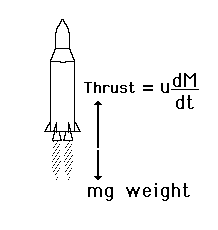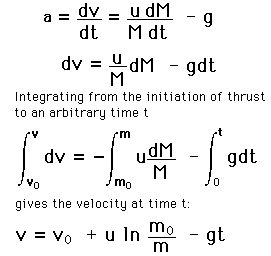Vertical Rocket
Under the influence of the rocket thrust and gravity, the acceleration is
 Calculation |
 |
Rocket propulsion
| HyperPhysics***** Mechanics ***** Newton's laws | R Nave |
Vertical Rocket Under the influence of the rocket thrust and gravity, the acceleration is
|
Index Rocket propulsion | ||
|
Go Back |
Rocket in SpaceUnder the influence of the rocket thrust in a gravity-free environment , the acceleration is
|
Index Rocket propulsion | ||
|
Go Back |
Rocket in SpaceUnder the influence of the rocket thrust in a gravity-free environment, the resulting velocity can be calculated from"
|
Index Rocket propulsion | ||||
|
Go Back |